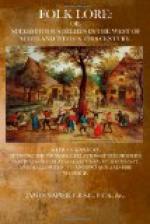Such theories left ample room for the creation of all sorts of cure charms, and when such ideas prevailed among the educated in the medical profession, we need not be surprised that they still survive among many uneducated persons, although two centuries have gone since. In 1714 one of the most eminent physicians in Europe, Boerhaave, wrote of chemistry and medicine:—“Nor even in this affair don’t medicine receive some advantage; witness the cups made of regulus of antimony, tempered with other metals which communicate a medicinal quality to wine put in them, and it is ten thousand pities the famous Van Helmont should have been so unkind to his poor fellow creatures in distress as to conceal from us the art of making a particular metal which he tells us, made into rings, and worn only while one might say the Lord’s Prayer, would remove the most exquisite haemorrhoidal pains, both internal and external, quiet the most violent hysteric disorders, and give ease in the severest spasms of the muscles. ’Tis right, therefore, to prosecute enquiries of this nature, for there is very frequently some hidden virtues in these compositions, and we may make a vast number of experiments of this kind without any danger or inconvenience.”
As it illustrates the theories just mentioned, we notice here the influence attributed to the wonderful Lee Penny. This famous charm is a stone set in gold. It is said to have been brought home by Lochart of Lee, who accompanied the Earl of Douglas in carrying Robert the Bruce’s heart to the Holy Land. It is called Lee Penny, and was credited with the virtue of imparting to water into which it was dipped curative properties, specially influential to the curing of cattle when diseased, or preventing them taking disease. Many people from various parts of Scotland whose cattle were affected have made application within these few years for water in which this stone has been dipped. It is believed that this stone cannot be lost. It is still in the possession of the family of Lochart.
Ague, it was believed, could be cured by putting a spider into a goose quill, sealing it up, and hanging it about the neck, so that it would be near the stomach. This disease might also be cured by swallowing pills made of a spider’s web. One pill a morning for three successive mornings before breakfast.




